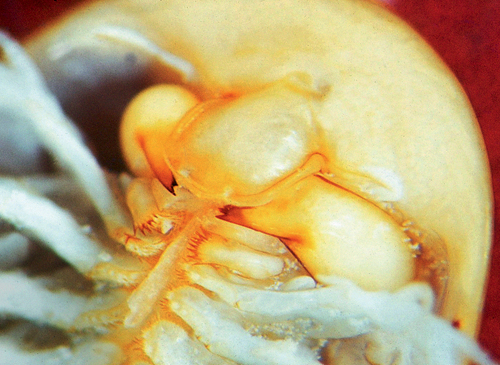
© J. DAY
20 |
Text by Jenny Day |
|---|---|

© J. DAY
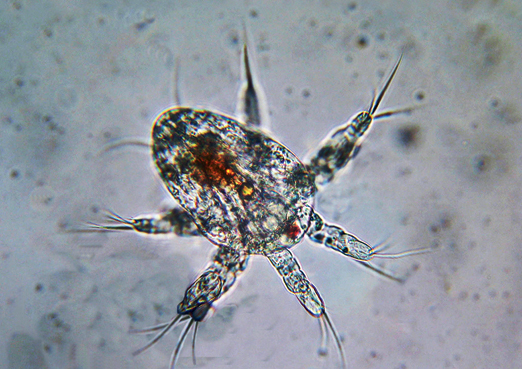
© LITHIUM57/CC BY SA 3.0
A diverse group of primitive crustaceans characterised by flattened leaf-like limbs (phyllopods) used for locomotion and respiration. One major group includes the larger fairy, shield and clam shrimps, and another, the much smaller water fleas. Beating of the flattened limbs allows the animals to swim, and at the same time to take in oxygen for respiration. The water current caused by this movement also brings in food particles that are ground up by a series of paired mandible-like ‘gnathobases’ (1, mandibles and gnathobases of Triops granarius) and then passed forward to the mouth. Large branchiopods are restricted to inland wetlands. The eggs of virtually all species in southern Africa are unable to hatch unless they have first been subjected to drying. On rehydration, minute nauplius larvae (1a) hatch from the egg and go through several larval stages. Growth is extremely rapid, and sexual maturity can be reached in a few days (see p.20 for reproductive adaptations of freshwater invertebrates).
Shield/tadpole shrimps
Order Notostraca
Large carapace covering head and thorax; paired compound eyes and a central ocellus (simple eye). Abdomen ends in two long segmented cerci. Only two genera: Triops (cosmopolitan in distribution) and Lepidurus, which does not occur in sub-Saharan Africa. Unlike the other large branchiopods, Triops feeds on small invertebrates and fish as well as plant material. It is a pest in Asian rice paddies, where it tends to uproot young seedlings.
2 Tadpole shrimp
Triops granarius

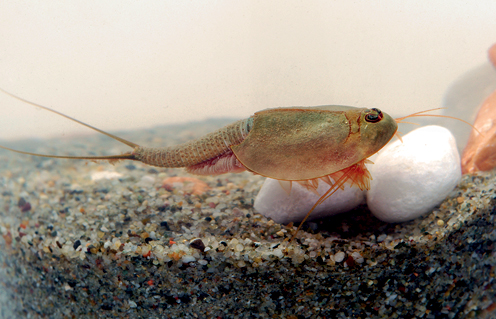
© RISE0011/CC BY SA 3.0
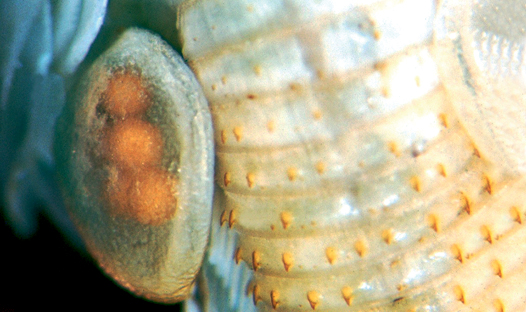
© J. DAY
Antennae minute; 35–70 pairs of phyllopods; part of the first pair of phyllopods antenna-like and sensory. Females (2) with a pair of brood pouches (2a) under the sides of the carapace. Size: Body up to 75mm in length. Biology: Current data suggest that T. granarius is the only species in southern Africa, but genetic analyses are needed to confirm this.
Fairy and brine shrimps
Order Anostraca
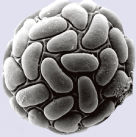
© J. DAY
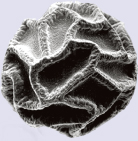
© J. DAY
Slender, graceful, transparent, often difficult to spot in nature. Body elongate; no carapace. Thoracic segments each with a pair of phyllopodous appendages; trunk ending in a pair of unsegmented terminal cerci. Second antennae small in females, in males large, often elaborate (3, antennae of a male Eubranchipus) and used to clasp the female during copulation. Details of antennal structure used for identification to species. Ornamentation of ‘egg cases’ or cysts is also species specific: dried cysts of Streptocephalus cafer (3a) and Branchipodopsis tridens (3b) show the variation in ornamentation. About 50 species in six or seven genera and four families are known from temporary pools in southern Africa.
4 Wolf’s fairy shrimp
Branchipodopsis wolfi
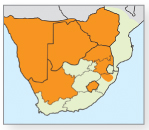
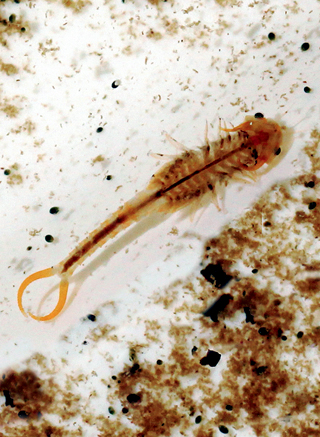
© J. RICHFIELD/CC BY SA 3.0
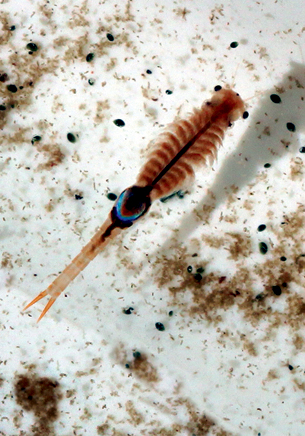
© J. RICHFIELD/CC BY SA 3.0
Male antennae short, with a short broad joint at base; egg sacs of female (4a) globular to oval; eggs bright blue turning brown. Caudal furcae (tail fork) bright orange. Size: Body 10–15mm in length. Biology: Usually found in small highly ephemeral rock pools. Grow and mature very rapidly. Widespread in Africa. RELATED SPECIES: Sixteen of the 20 Branchipodopsis species described are from southern Africa. Some species have differently coloured caudal furcae.
5 Purcell’s fairy shrimp
Streptocephalus purcelli

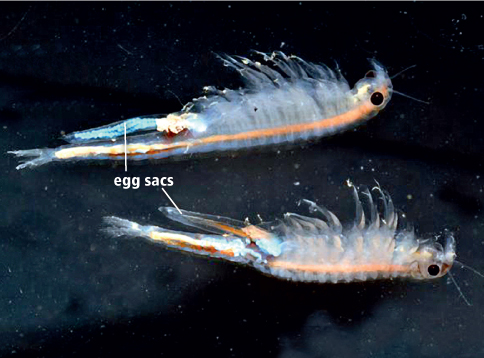
© C. REED
Antennae of male long, folded inwards. Egg sacs of female (shown here) long. Eggs bright blue turning brown. Body transparent. Size: Body up to 12mm in length. Biology: Usually in small highly ephemeral rock pools; endemic to the west coast. Grow and mature very rapidly. RELATED SPECIES: Twenty-two species described from southern Africa.
6 Brine shrimp
Artemia salina
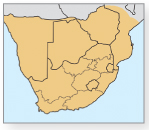
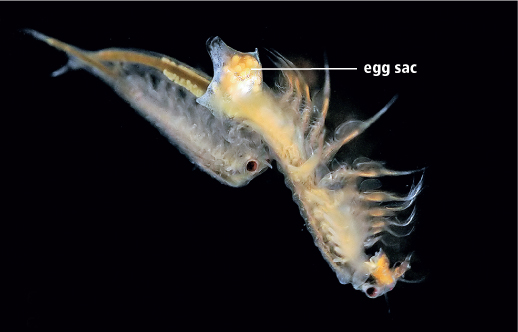
© HANS HILLEWAERT / CC BY SA 4.0
Flattened ends of male antennae broad and blade-like, together forming a wide scoop. Egg sac of female rounded; eggs pale or brown in colour, unadorned. Size: Body 6–10mm in length (southern African forms). Biology: Adapted to very high salinities. Important live food for aquarium fishes; eggs sold as ‘sea monkey’ eggs. Occur in large numbers in coastal saltpans. RELATED SPECIES: The taxonomy of Artemia is unresolved, and this cosmopolitan species may comprise a complex of closely related species.
Clam shrimps
Order Conchostraca
Small (3–18mm in length). Bivalved shell or carapace encloses the body. Numerous limbs. Large two-branched antennae used for swimming, burrowing and, by male, for clasping the female. Females carry numerous eggs in sacs on each side of the body. All but one (Cyclestheria hislopi) of the 18 species in six families in southern Africa confined to temporary waters.
1 Cape clam shrimp
Leptestheria rubidgei
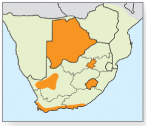
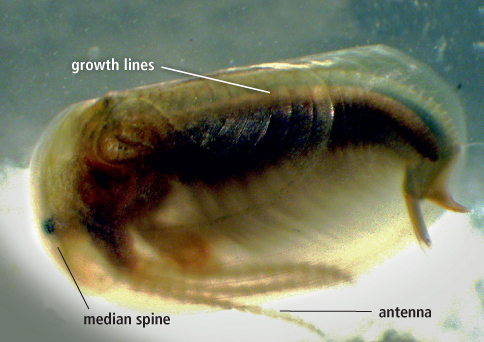
© B. VANSCHOENWINKEL
Shell with numerous distinct growth lines; rostrum with distinct median spine. Size: Body 0.8–1cm in length. Biology: Copulating pairs often remain joined, the male holding the female at a right angle in front of him. RELATED SPECIES: L. brevirostris occurs in Namibia, L. striatoconcha in Gauteng and Namibia.
Water fleas
Order Cladocera
Microscopic crustaceans, mostly in lakes and wetlands, including temporary ones. Dark compound eye mid-dorsally; conspicuous antennae used for swimming; 4–6 pairs of legs hidden in carapace. Parthenogenesis common. ‘Summer’ eggs small and numerous; 1–2 desiccation-resistant eggs in cases known as ‘ephippia’ produced in winter. No larval stage, juveniles resembling small adults. Morphologically similar to those found on other continents and may or may not be the same species. The southern African fauna needs proper taxonomic studies. About 50 species in six families known from the region.
2 Water fleas
Family Sididae
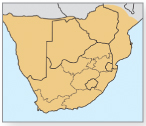
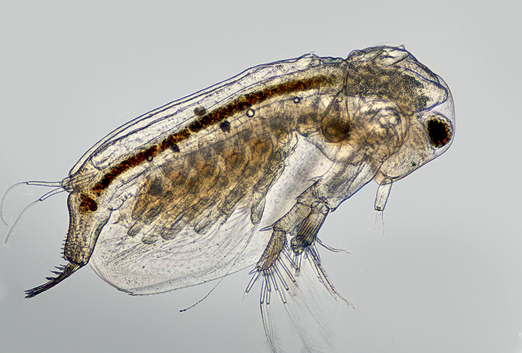
© NIKONUSER/CC BY SA 3.0
Relatively long and thin, with prominent head and big dark eye. Antennule small but visible. Resting eggs not carried in hardened egg cases (ephippia). Size: Body up to 1mm in length. Biology: Planktonic; an important food source for plankton feeders, including larger crustaceans and fish. Only Diaphanosoma excisum (2) from Lake Malawi and D. perarmatum from Namibia recorded from southern Africa.
3 Elephant water fleas
Family Bosminidae
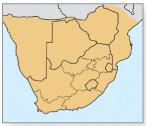
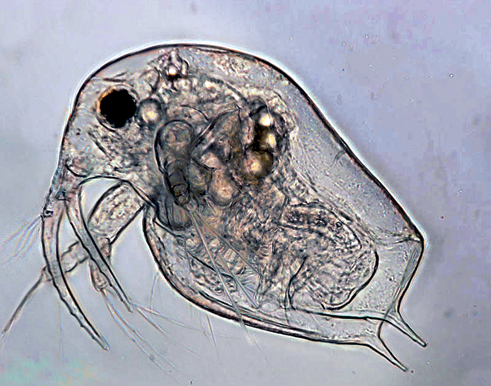
© B. LABER
Body rounded; head elephant-like with large antennules fixed anteriorly. Eye large and obvious. Size: Body <0.5mm in length. Biology: Planktonic; an important food source for predatory copepods and fish. Only the cosmopolitan Bosmina longirostris (3) known from southern Africa
4 Water fleas
Family Chydoridae
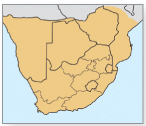
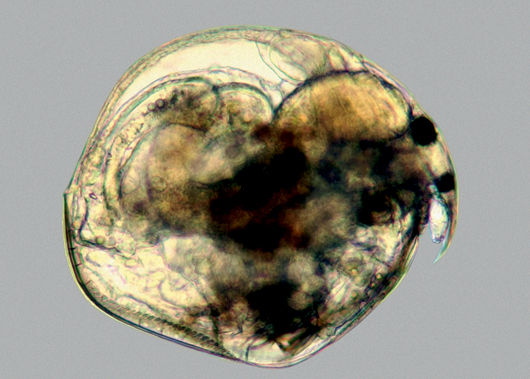
© M. STOREY
Small, with a convoluted intestine (Alona shown, 4). Head contiguous with body, antennae appearing through apparent lateral slits in the carapace. Hardened egg case (ephippium) with one egg. Size: Tiny, body <0.5mm in length. Biology: Bottom dwelling; commonly eaten by larger crustaceans. An undescribed species occurs in mountain streams in the Western Cape. At least 15 other species recorded from southern Africa, but the taxonomy is in need of revision.
5 Common water fleas
Family Daphniidae

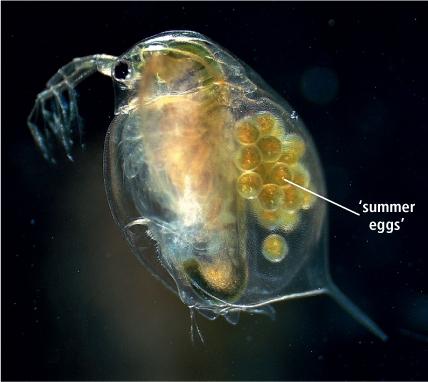
© HAJIMI WATANABE/CC/BY SA 3.0
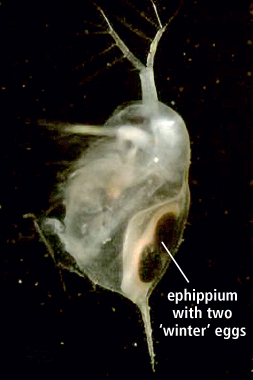
© C. REED
Large planktonic cladocerans, with prominent head and posterior spine. Regular ‘summer’ eggs usually numerous (Daphnia magna shown, 5), ephippia (egg cases) (5a) with two dark ‘winter’ eggs. Size: Body up to 2mm in length. Biology: One of the largest and commonest cladocerans; an important fodder species of planktivorous fishes. RELATED SPECIES: The family includes 22 known species in five genera from southern Africa. Daphnia barbata and D. dolichocephala are African endemics; Ceriodaphnia producta may be a Western Cape endemic.
6 Water fleas
Family Moinidae
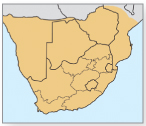

© A. NURHIDAYAH
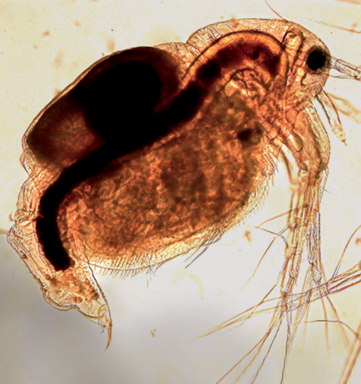
© J. HANEY
Delicate; body more or less globular, head rounded. Antennules obvious, cigar-shaped; 1–2 eggs in ephippium (egg case) (6a). Size: Body 0.8mm in length. Biology: Planktonic or benthic, mostly in temporary ponds and pools in the tropics and subtropics. Has some tolerance for saline waters. RELATED SPECIES: Four species of Moina (Moina micrura shown, 6) known from southern Africa.
7 Water fleas
Family Macrothricidae
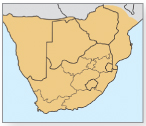
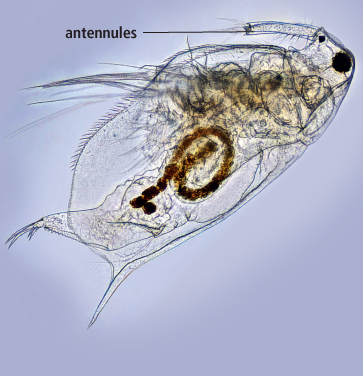
© NIKONUSER/CC BY SA 3.0
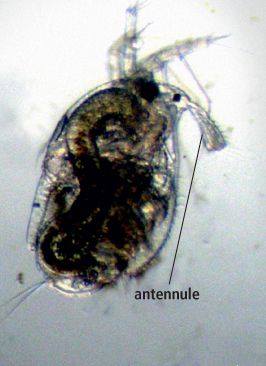
© PAOLOFON/NATURAMEDITERRANEO
Small, globular, benthic; large moveable antennules (7, 7a) inserted anteriorly on head. Size: Body up to 0.5mm in length. Biology: Found mostly in vegetated littoral fringes of wetlands. Five species in three genera known from southern Africa. Macrothrix spinosa (7) has a Gondwanan distribution; an undescribed species of Echiniscia may be a Western Cape endemic.